Episode 146
What you’ll learn in this episode:
- How Whitney has maintained relationships with clients since moving her studio from Chicago to Lake Geneva, Wisconsin
- Why the pandemic has changed the way we buy and sell jewelry for good
- Why Whitney sometimes turns down commissions and encourages clients to work with other jewelers
- How social media has changed the type of jewelry customers want
- How to find creative ways to give clients a luxury experience when you can’t meet in person
About Whitney Abrams
Whitney Abrams’ high-karat gold creations are a reflection of her love of the Renaissance aesthetic and her admiration for the technical abilities of the Ancients. Inspired by the rich tones of high-karat gold and intense hues of unique, precious stones, her hand-made pieces involve the wearer in an experience of regal beauty.
Her interest in intaglios and cameos has led her to develop relationships with several German carvers who provide her clients with custom carvings that connect them with Abrams’ creations on an unparalleled level.
Whitney has studied goldsmithing and exhibited her jewelry throughout the United States and Europe. Her work is included in a number of publications on the subject of jewelry as an art form and jewelry making techniques.
Whitney Abrams presents her collections privately to collectors throughout the country, as well as online.
Photos:
These are thick felt pouches, made in Italy, that can accommodate earrings, rings or a necklace. Then the clients can use them for travel. People really love them!
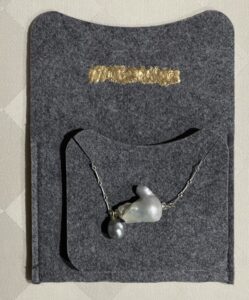
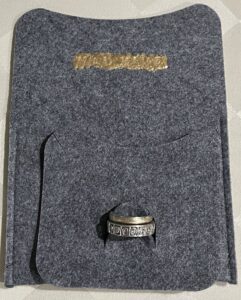
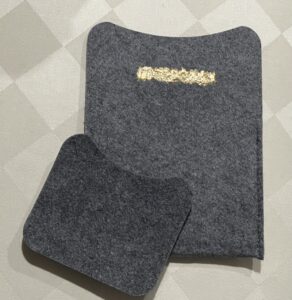
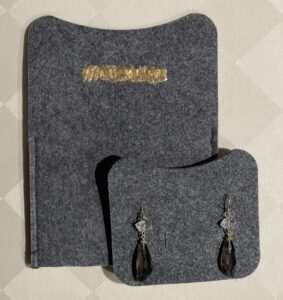
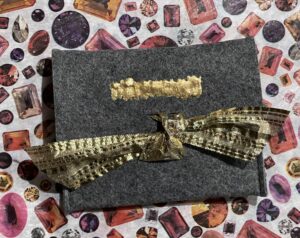
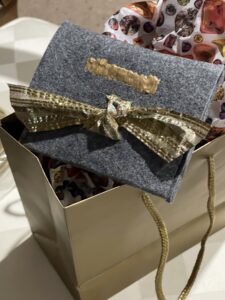
Additional Resources:
Transcript:
Since joining the Jewelry Journey Podcast as a guest in February 2020, maker and jewelry gallery owner Whitney Abrams’ life and business have changed dramatically: she moved away from her busy Chicago studio to vacation hotspot Lake Geneva, WI, and has spent the last year finding the inspiration that comes with a more relaxed lifestyle. Although it’s been challenging to provide customers with the luxury experience she’s known for in a pandemic, Whitney has discovered that the relationships she fostered with her customers can withstand the distance. She joined another episode of the Jewelry Journey Podcast to talk about what life is like in Lake Geneva; how she keeps in touch with longstanding clients; and how social media has helped her business grow. Read the episode transcript here.
Sharon: Hello, everyone. Welcome to the Jewelry Journey Podcast. This is a two-part Jewelry Journey Podcast. Please make sure you subscribe so you can hear part two as soon as it comes out later this week.
Today, my guest is Whitney Abrams, owner and founder of Whitney Abrams Jewelry, a private jewelry studio specializing in high-karat jewelry. Whitney was one of our pre-Covid guests in episode 62, which you can find in our podcast archives on the Jewelryjourney.com website. Today, we’ll hear Whitney’s jewelry journey and how she’s handled the challenges of continuing her business in the time of Covid. Whitney, welcome to the program.
Whitney: Great to see you again, Sharon. Thank you.
Sharon: You’re quite an accomplished high-karat goldsmith. For people who haven’t heard your story, can you tell us about your jewelry journey?
Whitney: Sure. Thank you for that compliment. I grew up loving jewelry. I came from a family that loved jewelry. My dad designed pieces over the years for my mom that he had other jewelers make, and my grandparents collected a lot of jewelry. Starting from when I was about seven, I was gifted with jewelry for every occasion. It was really part of the fabric of our family. I always had a penchant for stand-alone gems.
Although I went to school for communication studies at the University of Iowa, I found my way to a fine arts metals minor there. They had a nice jewelry department, so that fed into my interest in making. I learned how to fabricate. From there, I went into business—it was a national advertising sales position—for years, but I always did jewelry on the side. At my home I had, not a studio per se, but a maker’s room, I called it, because I didn’t have a torch. I continued taking studio time through the Lincoln Park Association in Chicago.
Subsequently, I found myself enjoying jewelry more than my full-time job. I ended up taking some classes overseas. I took a course in Ireland with a gentleman named Brian Clark—
Sharon: I’m sorry, in Ireland?
Whitney: In Ireland. It’s a town about an hour south of Dublin. He has a silversmithing course he offers in the summer. It’s an intensive program. I went for a month, and it was absolutely wonderful and immersive. You used the bellows to pump air into the flame with your foot while you’re standing on one foot and trying to solder. You’re learning things; you’re doing things that are done in a very different way than I had been exposed to in the States. It was absolutely wonderful. I learned how to use chafing tools and different hammers, and I made some bowls and things I hadn’t been exposed to before. That was really fabulous.
Then I ended up traveling a lot through Europe, and I came upon an exhibition in London. I stumbled upon the Ogden exhibition called “Greek Gold” at the British Museum. When I walked in there and saw all the Etruscan and the 22-karat, 24-karat granulated pieces, the handmade chains, I had an epiphany. I said, “This is it. This is what I’m going to do.”
When I got back home, I set my sights on finding places to learn how to do those techniques and work in high-karat jewelry. That took me to New York City. I ended up taking a couple of intensive courses in New York. At the time, there were about three Greek schools teaching those processes. I ended up being offered an apprenticeship because in five days, I had made seven significant pieces. They said, “This is your thing. You’ve got this.” So, I packed my bags, I moved to New York City, and that’s where I landed for years. I continued on there at Seebauer Studio for about a year. I learned a lot by watching the teaching going on and watching other students making things, people that had a lot more experience than I did.
Then I got my own studio space with a longtime friend of mine from seventh grade. She happened to live in New York City and was also taking jewelry classes, so we could share a studio. That led me, a couple of years later, to open Metal Kitchen, which was a jewelry-making school in Soho. We taught everything from marketing—I had experts in all the different fields come in, whether you should buy a safe, whether you should get jewelry insurance—to all the different techniques. I had traveling instructors from Italy and all over the United States and Canada come in to teach courses, which was really wonderful.
At that time, I was doing a lot of commission work and a lot of shows for the Philadelphia Museum of Art, Park Avenue Crafts and the American Craft Council, that show circuit for high-end crafts. That landed me at the dot com bust, where all the rents blew up in New York. So, I ended up having to close the school, which was very sad for me because I loved meeting all the different instructors and students, but our rent went astronomically high and it wasn’t possible to continue there.
At that point, I moved back to Chicago a couple of years later and opened my gallery in the Gold Coast area in Chicago. It was about two blocks off Michigan Avenue. I had that for 10 years, and then I went to a private studio about a block away. I maintained a lot of my customer base; probably about 1,000 steady people and 300 real collectors. I carried a lot of other artists’ work at the gallery, but I did a lot of commission work and a lot of my own pieces. I worked from my home studio.
During this time—I definitely spoke to you a couple of years before all this started—after living in my place for a year and not really being able to go out much between Covid and the atmosphere in Chicago in the last year and a half, I ended up moving up to Lake Geneva, which is a resort area in southern Wisconsin, about five miles over the border from Illinois. It’s about an hour and a half from where I was living. I have family up here and I have my studio, so I’m continuing to work. I’ve even had several of my customers who have become friends come up for lunch this summer and sit outside. We continue to make connections with people. They ordered some commissions, so we’re continuing on and it’s been great.
Sharon: Would you still call what you have a private studio? I know you really focused on the luxury aspect.
Whitney: I don’t have an open studio anymore as I did in Chicago, but I will come and meet people, and they are welcome to come to my studio by appointment. It is still, to some extent, more private than it was before, but it was more of a reaction to what was going on. I really did find that the stress I was under in Chicago over the last year and half sapped my energy and creativity. Being able to be outside and have my own space and not have to deal with—I was on a very busy corner that had a lot of police activity and things like that, so it wasn’t conducive to walking around with gemstones and fine metals. Things have turned around in terms of being able to sleep all night and create and have energy. The thought process is back, and it’s concentrating once again on the jewelry. So, that’s great.
Sharon: It sounds like it was very stressful there.
Whitney: It was a little stressful. You keep going through it and going through it, and when it seemed like there was an end, then something else happened. I just thought, “You know what? I think I need a change for a while.” Whether that means I go back or I don’t go back, I’m not sure yet, but things have certainly calmed down there, and I still have many friends that live there. I was there the other day, and things are getting a little more back to normal. We’ll see what happens, but for the moment I’m happy having my own studio again and making.
Sharon: Lake Geneva, you said it’s a vacation area. I’m not familiar with it.
Whitney: It’s one of the largest fresh-water lakes in the country, and it’s a big boating community. There are about 700 houses on the lake. A lot of families have had mansions here historically. It was a summer retreat for Chicago people going back many, many years, and there are a lot of old mansions here. It’s kind of like the Hamptons of Chicago, in terms of people can drive there in less than an hour and a half or two hours, get to their house, be on the lake, have their boats and park at the piers and go into town and have lunch or shop. It’s a whole lake life community up here. It’s wonderful to get up at 4:00, get up from your bed, go down and float on your raft for an hour and jump in the lake. It’s great.
Sharon: What do people do during the winter? Does it close down?
Whitney: There are a lot of things here in the winter. There are a lot of festivals, a lot of things that are based around cold weather and ice and ice sculpture. There’s an international ice sculpture competition here starting next week, and that happens every year. There’s skiing in the area. There’s ice fishing and snowmobiling. There are a lot of outdoor things going on even though it’s cold, which is probably foreign to you in the warmth of California, but it’s really embraced here.
There are a lot of people that are here year-round, and the year-round population here during Covid has expanded greatly. There are a lot more people where I’m living who have only come up three or four weekends or 10 weekends in the summer, but they are now permanently living here with their kids and they’re in school. It’s a lot of people that have left not just Chicago, but Milwaukee and other larger cities that are near here. There’s a whole system of lakes around here that have expanded the population during Covid. There’s definitely a lot going on.
Sharon: Wow! You brought some of your existing clientele, but how has it been in terms of—is it rebuilding? It’s such a change.
Whitney: It’s kind of rebuilding, but it’s kind of maintaining relationships that I’ve had. The one great thing about Zoom has been that you can show people gemstones; you can discuss pieces. One thing I have seen a shift in with my customers is, with the time we all spent at home organizing and cleaning things, they would say, “Oh my, I found a ring of my grandmother’s I forgot I had,” or “This is broken. I have four diamonds from this and a couple of stones from that. Would you have some tourmaline that would go with it?” We use Zoom calls instead of traveling and seeing each other in person, and that’s been really interesting. Then having Instagram, and being able to do trunk shows instead of being in-person at a jewelry show or having a trunk show at a jewelry store that happened to be closed down or didn’t want 20 people at a time in their shop, now that things have relaxed a tiny bit. It’s definitely been an adjustment.
Also, one of my opal dealers, who’s been an opal dealer for many years, he has a store in Lake Geneva where he sells opal jewelry. He and I have done a couple things together. There are several other jewelry stores in the towns around the lake. It’s a 26-mile lake, so there are several towns around the perimeter of the lake. It’s been very nice to connect with people who have shown at Tucson, who have been in the industry since the 70s and have an inventory of stones and other things I’ve needed. I’ve gone over to this woman in Lake Geneva and said, “Hey, do you have this? Do you have that?” and looked through her stones. It’s been very interesting. It’s kind of a shift.
Sharon: It sounds like a shift. I give you credit because you have to be flexible to turn on a dime like that.
Whitney: I thought, “Well, am I going to sit here and feel like doing nothing, or am I going to do something?” I just have to get going and do something. Chicago was interesting because they shut all the outdoor spaces down. You couldn’t walk along the lake. They closed everything and there were police blocking all the entrances. I think a lot of people that didn’t live there don’t realize that. Now, of course, all that has been taken away, but it was nine months of you’re not allowed to go to a park; you’re not allowed to go the lake, which was outside my door. It was a very different way of living, and this has really been great. It’s been wonderful. I’ve got some friends that also came up from Chicago. It’s moving to a small town, but thankfully I know some people. I’ve met a lot of very nice people. I’ve made some great connections. Between the internet and phone calls and Instagram, it’s been easy to keep in touch with my other clients.
Sharon: I didn’t realize you had a magazine background. I know in the past you had a done a lot with print.
Whitney: I did. When I was doing national ad sales, it was network television. That was not magazine-related; that was network television stations, but I did do a lot of advertising, as we discussed before, when I had my store. Print ads were wildly successful for me for the store. I think when you have a physical location people can come to, that makes a lot of sense. Up here, there are a lot of equestrian places and people that board their horses. I’ve been approached by a couple of magazines that cater to that because I have German carvers. I’ve had customers in Chicago who’ve given me pictures of their horses or their dogs, and the carvers put the animals on cameos. That’s something I’m looking at dipping back into.
Sharon: You segued so quickly, very successfully, to Instagram. How has that been during Covid? Tell us more about that.
Whitney: It’s been wonderful. I have enjoyed it. I have had nothing but positive experiences. I’ve connected to a lot of gem dealers. Everybody in the beginning was scrambling: “How is this going to work? The stores are closed. All the shows are canceled.” It was a collaborative opening for people to discuss, “How can we have a trunk show virtually? What software are you using? How are you doing this? What camera are you using?” People were open to sharing information and helping each other succeed and move through this time that no one had experienced before. So, that was really wonderful.
Then, because the gem shows were not happening—not that I need another gem, as I may have told you before. I had no business going to Tucson again, but it’s always fun, especially at a time when you couldn’t go out shopping or do anything. It was like, “Oh, look at those watermelon slices, O.K.” A lot of the gem dealers started posting, and I was starting to buy from people I hadn’t bought from, or maybe they showed in Tucson at a show I hadn’t been to. It was an introduction to a lot of people I hadn’t interacted with personally before.
In terms of my jewelry, I had never experienced where I would post a finished piece, and someone would buy it immediately off Instagram. That was something new, and that was a real lift when people were saying, “O.K., this is cancelled, that’s canceled, that’s canceled.” I started posting a lot of finished work, and I got a lot of commissions or people purchasing things right off of Instagram.
Sharon: Do you think things will go back? What’s the new normal with this?
Whitney: I don’t know. I think people are now very comfortable using technology they didn’t think they would be able to use. I’m not sure what the next thing is going to be because Instagram was so different. I was late to the game; I think I joined in 2016, but it keeps growing, and people are adapting along with it. There are a couple of artists who I think have done a neat job of doing release dates. They post in-process pieces, and there’s a timer you can put on your Instagram with the release date, and then they sell everything at once. A fabulous idea. It’s like having an instant trunk show, and people have the anticipation. I remember when retailers would release a new collection. It’s very similar. That’s really been interesting.
I’m hoping to go to the Tucson Gem Show at the end of this month. It seems like it’s going to go on. I’ve had messages from some of my dealers saying they’re not coming from Brazil or China, but most people seem like they’re coming from Germany, so we’ll see what’s going to happen with that. I don’t think those shows may ever be as large as they have been in the past.
Sharon: So, Tucson is still on. I know because I’ve had trips canceled that are in March or April already.
Whitney: I know. They’re saying Tucson is still on. I’m supposed to go on the 28th of January. We shall see.
Sharon: Well, I hope so
Whitney: It’s getting close. I don’t know what the rules are. It’s so up in the air, especially with the little peak of Covid we’re having now, but fingers crossed. I have literally not been on an airplane since Tucson in 2020. That was my last trip. I hope it goes on, but if it doesn’t—I’ve booked trips over the past two years that I’ve canceled, but I would like to go. If I can’t go, I can’t go.
Sharon: I hope you can go. I hope it’s a go.
Whitney: I know. Everything’s a little bit out of our control right now, so just roll with it and see what happens. I can cancel my hotel, so I’m not worried about it. They’ve already changed both of my flights to different flights entirely, and that was like six weeks ago, so who knows?
Sharon: I hope you do get to go. Maybe there will be some normalcy in the world. I do think once I get past the hunger for being able to go shows, it will be a new normal.
Whitney: It’s the camaraderie of our group of friends that is so wonderful. The people in this industry are so delightful. WhatsApp has been another thing. I don’t know if you use that. That has been a neat connection to a lot of my friends in Europe. We call each other. We travel. One of my friends who’s a gem dealer from the East Coast, they spontaneously went to Italy. I couldn’t believe they picked up and went before Christmas, but I told them all the jewelry-related places to go in Florence. I lived in Florence for a while. They had the best time. It was so fun, and I said, “I’m going to live vicariously through you.”
Sharon: That’s great. Italy is on my list when the world opens up a little more. Maybe it’s just America that is so closed. When it opens, you hear about everybody traveling. You have to share your vaccination card, but you know.
Whitney: Right, I know.

